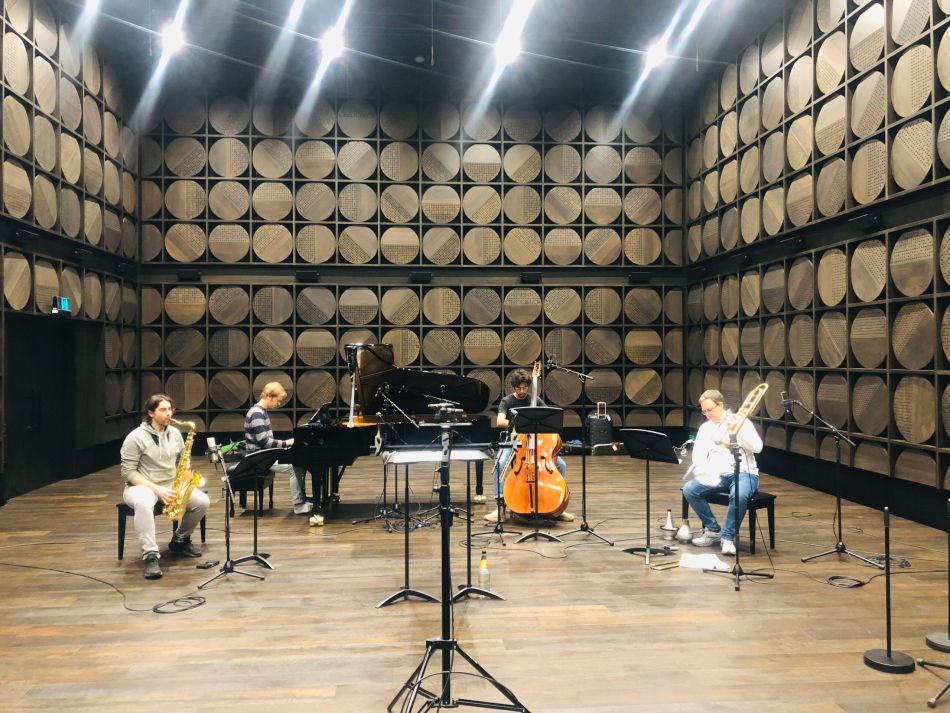Description
instrumentation: tenor saxophone, trombone, piano, double bass
date: 2019
duration: 12’00
details: 36 pages, including performance instructions; A3 portrait, full colour
Programme Note
Self-Portrait, Three Times, Standing (15.3.1991–20.3.1991) is the first in a pair of quartets based on the self-portraits of the painter Gerhard Richter—along with Self-Portrait, 1996—which together form the collection A way of making ghosts. The Richter work from which this piece takes its title is a collection of six overpainted photographs. The six prints are identical, with triple-exposed black-and-white images of the artist in his studio—ghostly, faint, hardly visible in three separate locations, and only barely distinguishable from the shadows in the room—against a repeating background of the artist’s own paintings hung from the studio’s walls. On each photograph, Richter then paints, using his traditional squeegee technique, thick horizontal blobs of bright red paint pulled from left to right, each of the six with slightly different densities and saturations of colour, from reasonably sparse to thick and mangled. This paint obfuscates and obliterates the image below while simultaneously ‘making real’ the physical surface of the print itself. One is immediately aware of the gap between the surface of the paint, the surface of the print, and the space of the image of the photograph, flattening three-dimensional spaces and giving depth to two-dimensional ones.
That this is a self-portrait is important, particularly when viewed through this layered, multiple, and uncertain stacking of realities. Richter’s images show the self-portrait both as a reality and a fabrication, a replication and a sleight-of-hand misdirection, and a challenging jumble of truths around which of these layers is the real ‘material’ of the work. Richter himself becomes a depiction of a very real person in a very real space in a very unreal photograph; the paint has the most direct connection to the hand of the artist and is the most tangibly ‘real’, but also serves principally to obscure the more personal and more photographically real elements beneath; and the densest overpainting—which completely conceals all three Richters in three of the six photos—is perhaps the most ‘real’ representation of self, not as a contrived masking or mutilation of self-representation but rather as an acknowledgement that Richter’s artistic personality sits somewhere in the tension between the layers. It is that tangled interaction that is, in the end, the ‘Self-Portrait’ of the work’s title.
Unlike Richter’s many self portraits, here I haven’t used/re-used any existing materials, but this new quartet does come from a larger path in my recent work that aims to re-examine and repurpose some of the spaces I’ve opened up over the last 20 years or so. It’s not so much a return or re-use as it is a kind of provocation to myself, a reminder that there’s unfinished business with some of what I’ve made in the past, and also an acknowledgement that there remains a gap between what I’ve made and what I wanted to have made. The piece is a ‘working through,’ a ‘trying again’, but then is also an effacing of those materials, and that effacing is its own reality and its own ‘self’. (The Richter work is not dissimilar—it is a kind of re-staging of Self-Portrait, Three Times, five (seated) images in the same studio space from early 1990.)
Finally, the self-reflection also is apparent in the work’s not-particularly-veiled link to jazz, not least through the keyboard part, which is full of direct and indirect references to McCoy Tyner, Art Tatum, Thelonius Monk, and Cecil Taylor. The saxophone part, while a bit less explicitly referential, betrays the fact that for most of my adult life my favourite musician has been John Coltrane, and I’ve found his approach to the relationship between material and expression particularly inspiring and personal. Through the years planning and writing the piece, I always referred to it as my ‘jazz quartet’. Ironically it involves no improvisation—something I’ve been working with quite a lot in various ways since 2013 or so—but nevertheless the piece’s materials and structures all come unabashedly from the fact that I’ve spent at least a few hours nearly every day for nearly 25 years immersing myself in that repertoire.
The work is written for and dedicated to ELISION, and was supported by a generous grant to the Centre for Research in New Music (CeReNeM) from the University Research Fund at the University of Huddersfield. Many thanks to ELISION’s Joshua Hyde, Benjamin Marks, Alex Waite, and Kathryn Schulmeister for their invaluable assistance in the development process of many of the materials and techniques used in this work, and to Daryl Buckley, for his friendship, as ever.


























